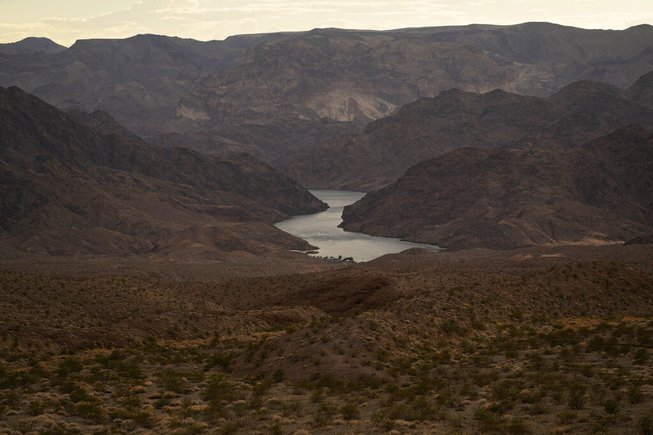
John Locher / AP
Water flows down the Colorado River downriver from Hoover Dam in northwest Arizona, on Aug. 14, 2022, near the Lake Mead National Recreation Area.
Sunday, Dec. 17, 2023 | 2 a.m.
View more of the Sun's opinion section
Nearly 100 years after the Colorado River Compact was negotiated, big changes are finally coming for senior water rights holders — at least in the short term.
On Wednesday, at the annual meeting of the Colorado River Water Users Association in Las Vegas, several large California water districts and U.S. Bureau of Reclamation officials announced a series of 21 short-term (one- to two-year) water conservation agreements that will save 1.6 million acre-feet of Colorado River water through 2026. An acre-foot of water is about 326,000 gallons, or enough to serve two to three households annually.
Any progress in conserving the West’s dwindling water supplies should be celebrated, and we are hopeful that the new short-term accords will pave the way to a new, long-term “law of the river” negotiated among seven Western states, tribes and Mexico before the expiration of the current compact in 2026.
However, that hope and optimism is tempered by the reality that last week’s agreements were only made possible by an extremely wet year in the West and a massive infusion of federal money from President Joe Biden’s Inflation Reduction Act that helped grease the wheels of compromise.
Neither of these circumstances can be relied on in the long term, especially with Republicans now in control of the House of Representatives and Biden facing an uncertain election just 11 months from now.
“Time is not on our side,” Adel Hagekhalil, general manager for the Metropolitan Water District of Southern California said during the meeting. “Nature threw us a lifeline this year.”
He’s right.
Yet, while the long-term outlook for sustaining the Colorado River remains uncertain, the short-term climate of abundance presents an opportunity for more thoughtful negotiations on the needs of communities throughout the West and across America.
Approximately 40 million people rely on the Colorado River for their basic water supply, but water from the river is also essential to the economy of the West.
Much of the water savings announced last week will be realized via voluntary cuts and renegotiated contracts with California’s Imperial Irrigation District (IDD). It holds the largest single allocation of Colorado River water in the U.S. and until recently, was largely immune to cuts in its water usage because it also holds the most senior water rights.
That has been an acceptable status quo in years past because the Imperial Valley produces nearly $3 billion in crops and livestock each year. Without the Inflation Reduction Act, it’s unclear whether the IDD would have agreed to short-term cuts.
In other words, a new river compact isn’t just about water conservation, it’s about the economic viability of communities that benefit from the river whether via agriculture, ecotourism and more.
When the Colorado River Compact was first negotiated a century ago, the amount of available water was vastly overestimated, and more water was allocated than could possibly be delivered. We’ve been depleting the river ever since. Only now, climate change has caused the amount of water to decline more rapidly, and the amount of people who rely on the Colorado’s water has exploded.
To put it bluntly, there is simply not enough water in the Colorado to sustain the level of consumption we currently demand. There never has been and there likely won’t be. Ever.
The surprisingly wet winter of 2022-23 created some breathing room for negotiations, but long-term solutions must be found sooner rather than later. Those solutions must prioritize the baseline needs and long-term viability of communities in the West, but they cannot forget the river’s role as an engine of the domestic economy and food supply.
For the affected states to survive, any new agreement will require everyone to sacrifice and make decisions using real data derived from the river itself, rather than the wishful thinking of politicians and developers.
The states in the upper Colorado watershed must agree to play fair with the states in the lower watershed, and all states must agree to respect longstanding water rights of Indigenous tribes in the negotiations and take their needs seriously.
The cities of the Colorado watershed must be extremely sensitive to the needs of agriculture, providing financial assistance to farmers as they transition to low-water crops and farming techniques. This will likely mean that certain water-intensive crops will no longer be able to be grown in the region.
All parties to the agreement must be expected to cut per-capita water use down to a shared, normalized and sustainable level that places the human need to access clean and reliable drinking water above aesthetic issues like ornamental grass. New developments must be able to identify a sustainable source for their water needs. Also there must be a review of attempts by foreign countries — notably Saudi Arabia — to purchase huge blocks of land in order to control the water rights associated with the land purchases.
And our neighboring states should look to Las Vegas, long at the forefront of visionary water management, for examples and inspiration.
We’ve issued this call before, but as we celebrate last week’s short-term agreements, it’s a good time to remind ourselves of what’s at stake in negotiations over the law of the river.
We cannot rely on unusually wet winters or the influx of billions in federal dollars to save us moving forward.
But if we rise to the moment, set aside our sense of personal entitlement and find a sustainable agreement, we can earn the opportunity to be looked upon as heroes by those who follow us. If we don’t, future generations will visit the dry, abandoned, hollowed out husks of once-great cities and wonder, “Why did they let this happen? They knew better.”
